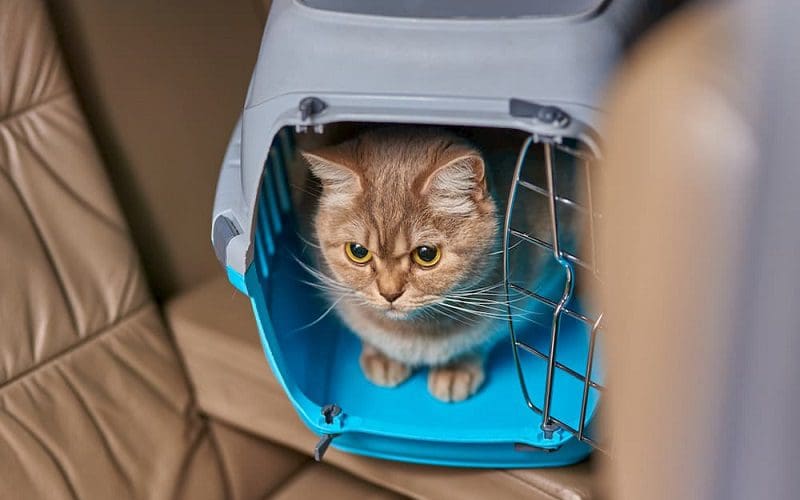Last Updated: 3 months ago
Rehoming cats can be a difficult decision, but it doesn’t have to be a stressful one.
We’ll show you how to rehome cats and help you understand the process so you can ensure that they have a smooth transition to their new home.
From finding the perfect home for your cat to making sure they settle in comfortably, this guide will provide you with all the information you need on how to rehome cats successfully.
So let’s not wait any longer—let’s start rehoming cats!
Tips And Advice on How to Rehome A Cat

When it comes to finding a new home for your beloved cat, the process can be overwhelming and stressful.
It’s important to take your time and do some research in order to find the best place for them.
The first step is to ask around; friends or family may know of someone who would love to have a furry friend join their household.
If you have the means, visiting prospective homes is always beneficial, as you will get an idea of what kind of environment they provide and if it would be suitable for your pet.
Once you have found a place, make sure to introduce your cat slowly to its new surroundings by providing plenty of love and attention during this transition period.
Let them explore at their own pace and give them time alone when needed so they feel comfortable in their new home.
Try bringing along familiar items, such as toys or blankets, from their old home so that they feel more secure in unfamiliar territory.
Finding a new home for your cat doesn’t have to be difficult! With patience and understanding on both sides, this transition can go smoothly with minimal stress involved.
Preparing Your Cat for the Move

Moving can be a stressful experience for both humans and cats.
While you may have already taken the necessary steps to prepare yourself, it’s important to remember that your cat needs some extra attention during this time as well.
First Step
The first step in preparing your cat for a move is packing its belongings.
Make sure you have all of their essentials, such as food, water bowls, litter boxes, toys, and bedding, packed securely in advance so they are ready to go when the time comes.
If possible, try not to pack any items that smell like home or remind them of where they used to live; this could cause unnecessary stress for them.
Second Step
Once everything is packed up and ready to go, it’s time to start acclimating your cat to its new surroundings.
This can be done by introducing them slowly over several days or weeks before the actual move date, if possible.
Try taking short trips around the area or spending some quality time playing in the backyard together so they get familiar with their new environment.
Final Step
On moving day itself, make sure to keep your cat safe and secure inside a cat carrier or kennel during transport.
Minimizing any anxiety caused by unfamiliar sights and sounds along the way and ensuring their safety throughout the journey.
Making the Transition to Their New Home

Moving to a new home can be an exciting but stressful experience, especially for cats.
Here are a few tips on how to help your cat adjust to its new environment.
- Create a safe space: Make a small room or area where your cat can feel comfortable and secure. This should include all of their essentials, like food, water, a litter box, bedding, and toys.
- Gradually introduce the cat to the rest of the house: Instead of introducing them to every corner of the house right away, let them explore at their own pace and get gradually used to the smells and sounds.
- Encourage playtime and TLC: During this adjustment period, it’s important to give them lots of love and attention from family members or pets living in the house.
Cats are creatures of habit and may need some extra help adjusting to their new environment.
Settling in and Adjusting to Change

When rehoming a cat, it’s best to give them some space and let them explore at their own pace.
Put out food, water, and a litter box in a quiet room with all of the doors closed until they are used to being there.
This will help reduce stress levels by providing a safe area where they can relax without feeling overwhelmed by stimuli from other rooms or people coming in and out of the house.
Remember, cats are creatures of habit who thrive on routine, so try not to change things up too drastically.
Make sure you keep feeding times consistent with what they were used to before moving. This will help them adjust more easily since familiar smells may trigger positive memories associated with mealtime.
Provide plenty of places for them to hide, such as cardboard boxes or cat beds; this helps cats feel secure when adjusting to unfamiliar environments.
If you notice any signs of distress, such as excessive meowing, crying, or hiding under furniture, talk to your vet about options like pheromone sprays.
These types of products have been proven effective in calming anxious cats during stressful situations like relocation.
Consider talking with an animal behaviorist if needed, as they specialize in helping pets adjust better after big changes.
Ensuring a Smooth Transition for Everyone Involved

It’s important to make sure that the transition is as smooth and stress-free as possible for both you and your new pet.
Here are some tips on how to ensure a successful transition:.
1. Start with Scents
Before bringing your new cat home, it’s important to get them used to each other’s scent.
You can do this by exchanging blankets or toys between the two of you so they become familiar with one another before meeting in person.
This will help reduce any initial anxiety or fear when they first meet face-to-face.
2. Provide Comfort Items
Make sure your new cat has plenty of hiding spots and comfort items, such as beds, scratching posts, and toys, available in their new home environment from day one so they feel safe and secure right away.
3. Take Things Slow
Allow your cats time to adjust at their own pace without forcing interactions between them too soon.
Remember that cats are creatures of habit who need time to settle into a routine before feeling comfortable enough around strangers.
4. Monitor Behavior Closely
Keep an eye out for signs of aggression or distress during the adjustment period. These could include hissing, growling, and swatting.
Address these behaviors immediately with positive reinforcement training or calming pheromone diffusers, if necessary.
5. Be Patient and Understanding
Rehoming a cat takes time; give yourself and your kitty grace during this transition period until everyone settles into their happy place.
Rehoming cats should not be taken lightly, but when done properly, it can provide them with a better quality of life than ever before.
Wrap-Up
Rehoming a cat can be an exciting but daunting process.
By following the proper steps and considerations outlined in this article, you can ensure a smooth transition for your cat to a new loving home.
Remember, rehoming should always prioritize the cat’s well-being and happiness.
Whether you’re facing challenges with allergies, lifestyle changes, or other circumstances, taking the time to find the right new home for your cat is a responsible and compassionate decision.

Olfa knows how to get things done and has a keen business sense that others admire. She’s always on the go, coming up with new ideas! Her ability to anticipate the needs of her readers and deliver information that they want is what makes CatVills such a success. She loves cuddling her cat Picaciu. He is her inspiration.
